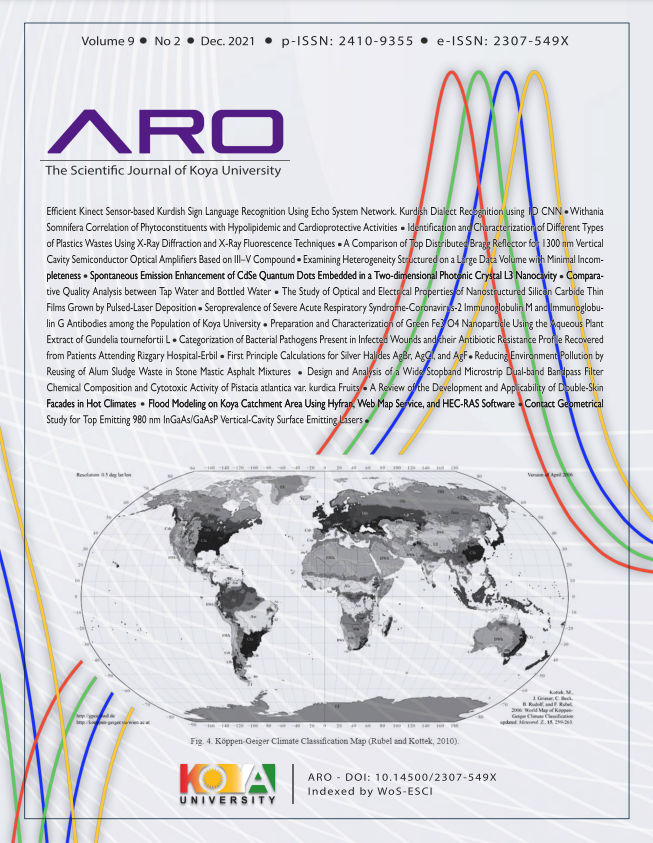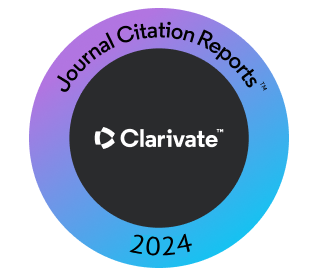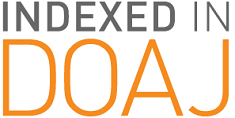Seroprevalence of Severe Acute Respiratory Syndrome-Coronavirus-2 Immunoglobulin M and Immunoglobulin G Antibodies among the Population of Koya University
DOI:
https://doi.org/10.14500/aro.10831Keywords:
Anti-severe acute respiratory syndromecoronavirus-2 Antibody, Coronavirus, Coronavirus disease-19, Immunoglobulin G, Immunoglobulin M.Abstract
Coronavirus is a pandemic disease. In most cases, the exact infection rate cannot be determined as not everybody can be tested for the virus, even though some of them carry the virus silently. Therefore, detection of antibodies of this virus is more practical to give us a better clue about the rate of infection because the asymptomatic people can be tested too. The serological detection of anti-Severe Acute Respiratory Syndrome-Coronavirus (SARS-COV-2) antibodies among asymptomatic and moderate symptomatic individuals gives us the vital point to understanding the prevalence rate of COVID-19 among the population. Total of (436) volunteers were participated, (96) from teaching staff, (172) employee, and (168) students. Anti-SARS-COV-2 immunoglobulin G (IgG) and Immunoglobulin M (IgM) were detected in the serum by ELISA technique, and complete blood count was performed for all participants. The number of seropositive of anti-SARS-COV-2/IgG was (159), whereas IgM was (66). The highest prevalence rate of IgG detected among participants with family member infected with coronavirus (42.7%). Total WBCs count significantly increased among IgM positive participants. Many asymptomatic people were infected with coronavirus, which lead to more spreading of the virus among the population. Therefore, mass screening of the population for specific antibody against coronavirus is important to reduce the infection rate.
Downloads
References
Acik, D.Y. and Bankir, M., 2021. Relationship of SARS-CoV-2 pandemic with blood groups. Transfusion Medicine Hemotherapy, 382, pp.1-7.
Azkur, A.K., Akdis, M., Azkur, D., Sokolowska, M., van de Veen, W., Brüggen, M.C., O’Mahony, L., Gao, Y., Nadeau, K. and Akdis, C.A., 2020. Immune response to SARS‐CoV‐2 and mechanisms of immunopathological changes in COVID‐19. Allergy, 75, pp.1564-1581.
Bendavid, E., Mulaney, B., Sood, N., Shah, S., Bromley-Dulfano, R., Lai, C., Weissberg, Z., Saavedra-Walker, R., Tedrow, J. and Bogan, A., 2021. COVID-19 antibody seroprevalence in santa clara county, california. International Journal of Epidemiology, 50, pp.410-419.
Britton, T., Ball, F. and Trapman, P.J.A., 2020. The Disease-Induced Herd Immunity Level for COVID-19 is Substantially Lower than the Classical Herd Immunity Level. CDC and PREVENTION, 2020. COVID-19 Pandemic Planning Scenarios. United States Centers for Disease Control, United States.
Dimonte, S., Jalal, P.J., Ahmad, H.A., Karim, S.B., Soor, T.A.H., Ali, S.I., Babakir-Mina, M. and Greco, F., 2020. Is the SARS-CoV2 evolved in human being: A prospective genetic analysis. Kurdistan Journal of Applied Research, 5, pp.169-177.
Feng, X., Li, S., Sun, Q., Zhu, J., Chen, B., Xiong, M. and Cao, G., 2020. Immune-inflammatory parameters in COVID-19 cases: A systematic review and meta-analysis. Frontiers in Medicine, 7, p.301.
George, C.E., Inbaraj, L.R., Chandrasingh, S. and Witte, D., 2021. High seroprevalence of COVID-19 infection in a large slum in South India; what does it tell us about managing a pandemic and beyond? Epidemiology Infection, 149, pp.e39.
George, C.E., Norman, G., Wadugodapitya, A., Rao, S.V., Nalige, S., Radhakrishnan, V., Behar, S. and de Witte, L., 2019. Health issues in a Bangalore slum: Findings from a household survey using a mobile screening toolkit in Devarajeevanahalli. BMC Public Health, 19, pp.1-12.
Guzik, T.J., Mohiddin, S.A., Dimarco, A., Patel, V., Savvatis, K., Marelli-Berg, F.M., Madhur, M.S., Tomaszewski, M., Maffia, P. and D’Acquisto, F., 2020.
COVID-19 and the cardiovascular system: Implications for risk assessment, diagnosis, and treatment options. Cardiovascular Research, 116, pp.1666-1687.
Hellewell, J., Abbott, S., Gimma, A., Bosse, N.I., Jarvis, C.I., Russell, T.W., Munday, J.D., Kucharski, A.J., Edmunds, W.J. and Sun, F., 2020. Feasibility of controlling COVID-19 outbreaks by isolation of cases and contacts. The Lancet Global Health, 8, pp.e488-e496.
Howard, J., Huang, A., Li, Z., Tufekci, Z., Zdimal, V., van der Westhuizen, H.M., von Delft, A., Price, A., Fridman, L. and Tang, L.H., 2020. Face Masks Against COVID-19: An Evidence Review. Available form: https://www. preprints.org. [Last accessed on 2021 Jun 01].
Huang, C., Wang, Y., Li, X., Ren, L., Zhao, J., Hu, Y., Zhang, L., Fan, G., Xu, J. and Gu, X., 2020. Clinical features of patients infected with 2019 novel Coronavirus in Wuhan, China. The Lancet, 395, pp.497-506.
Lauer, S.A., Grantz, K.H., Bi, Q., Jones, F.K., Zheng, Q., Meredith, H.R., Azman, A.S., Reich, N.G. and Lessler, J., 2020. The incubation period of Coronavirus disease 2019 (COVID-19) from publicly reported confirmed cases: Estimation and application. Annals of Internal Medicine, 172, pp.577-582.
Leffler, C.T., Ing, E., Lykins, J.D., Hogan, M.C., Mckeown, C.A. and Grzybowski,A., 2020. Association of country-wide Coronavirus mortality with demographics, testing, lockdowns, and public wearing of masks. American Society of Tropical Medicine and Hygiene, 103, pp.2400-2411.
Li, F., Li, W., Farzan, M. and Harrison, S.C., 2005. Structure of SARS coronavirus spike receptor-binding domain complexed with receptor. Science, 309, pp.1864-1868.
Liu, K., Fang, Y.Y., Deng, Y., Liu, W., Wang, M.F., Ma, J.P., Xiao, W., Wang, Y.N., Zhong, M.H. and Li, C.H., 2020. Clinical characteristics of novel coronavirus cases in tertiary hospitals in Hubei Province. Chinese medical Journal, 133, p.1025.
Merza, M.A., Al Mezori, A.A.H., Mohammed, H.M. and Abdulah, D.M., 2020. COVID-19 outbreak in Iraqi Kurdistan: The first report characterizing epidemiological, clinical, laboratory, and radiological findings of the disease. Diabetes and Metabolic Syndrome: Clinical Research and Reviews, 14, pp.547-554.
Nakano, Y., Kurano, M., Morita, Y., Shimura, T., Yokoyama, R., Qian, C., Xia, F., He, F., Kishi, Y. and Okada, J., 2021. Time course of the sensitivity and specificity of anti-SARS-CoV-2 IgM and IgG antibodies for symptomatic COVID-19 in Japan. Scientific Reports, 11, pp.1-10.
Oran, D.P. and Topol, E., 2020. Prevalence of asymptomatic SARS-CoV-2 infection: A narrative review. Annals of Internal Medicine, 173, pp.362-367.
Pourali, F., Afshari, M., Alizadeh-Navaei, R., Javidnia, J., Moosazadeh, M. and Hessami, A., 2020. Relationship between blood group and risk of infection and death in COVID-19: A live meta-analysis. New Microbes New Infections, 37, pp.100743.
Racine, R. and Winslow, G.M., 2009. IgM in microbial infections: Taken for granted? Immunology Letters, 125, pp.79-85.
Rosenberg, E.S., Tesoriero, J.M., Rosenthal, E.M., Chung, R., Barranco, M.A., Styer, L.M., Parker, M.M., Leung, S.Y.J., Morne, J.E. and Greene, D., 2020. Cumulative incidence and diagnosis of SARS-CoV-2 infection in New York. Annals of Epidemiology, 48, pp.23-29.e4.
Sarhan, A.R., Flaih, M.H., Hussein, T.A.and Hussein, K.R., 2020. Novel Coronavirus (COVID-19) Outbreak in Iraq: The First Wave and Future Scenario, medRxiv.
Shakiba, M., Nazari, S.S.H., mehrabian, F., Rezvani, S.M., Ghasempour, Z. and Heidarzadeh, A., 2020. Seroprevalence of COVID-19 Virus Infection in Guilan Province, Iran, MedRxiv. Siedlinski, M., Jozefczuk, E., Xu, X., Teumer, A., Evangelou, E., Schnabel, R.B., Welsh, P., Maffia, P., Erdmann, J. and Tomaszewski, M., 2020. White blood cells and blood pressure: A mendelian randomization study. Circulation, 141, pp.1307-1317.
Sun, Y., Zhou, J. and Ye, K., 2021. White blood cells and severe COVID-19: Amendelian randomization study. Journal of Personalized Medicine, 11, p.195.
Teng, Y., Xu, J., Zhang, Y., Liu, Z. and Zhang, S., 2020. Mendelian randomization in COVID-19: Applications for cardiovascular comorbidities and beyond. EBioMedicine, 57, p.102847.
Wang, S., Fu, L., Huang, K., Han, J., Zhang, R. and Fu, Z., 2021. Neutrophilto-lymphocyte ratio on admission is an independent risk factor for the severity and mortality in patients with Coronavirus disease 2019. Journal of Infection, 82, pp.e16-e18.
WHO, 2020a. Considerations for Implementing and Adjusting Public Health and Social Measures in the Context of COVID-19: Interim Guidance, 14 June 2021. World Health Organization, Geneva.
WHO, 2020b. Population-Based Age-Stratified Seroepidemiological Investigation Protocol for COVID-19 Virus Infection, 17 March 2020. World Health Organization, Geneva.
Wölfel, R., Corman, V.M., Guggemos, W., Seilmaier, M., Zange, S., Müller,M.A., Niemeyer, D., Jones, T.C., Vollmar, P. and Rothe, C., 2020. Virological assessment of hospitalized patients with COVID-2019. Nature, 581, pp.465-469.
Wu, Y., Feng, Z., Li, P. and Yu, Q., 2020. Relationship between ABO blood group distribution and clinical characteristics in patients with COVID-19. Clinica Chimica Acta, 509, pp.220-223.
Xu, X., Sun, J., Nie, S., Li, H., Kong, Y., Liang, M., Hou, J., Huang, X., Li, D. and Ma, T. 2020. Seroprevalence of immunoglobulin M and G antibodies against SARS-CoV-2 in China. Nature Medicine, 26, pp.1193-1195.
Zhao, J., Yang, Y., Huang, H., Li, D., Gu, D., Lu, X., Zhang, Z., Liu, L., Liu, T. and Liu, Y. 2020. Relationship between the ABO blood group and the Coronavirus Disease 2019 (COVID-19) Susceptibility. Clinical Infectious Diseases, 73(2), pp.328-331.
Zhu, B., Feng, X., Jiang, C., Mi, S., Yang, L., Zhao, Z., Zhang, Y. and Zhang, L., 2021. Correlation between white blood cell count at admission and mortality in COVID-19 patients: A retrospective study. BMC Infectious Diseases, 21, pp.1-5.
Downloads
Published
How to Cite
Issue
Section
License
Authors who choose to publish their work with Aro agree to the following terms:
-
Authors retain the copyright to their work and grant the journal the right of first publication. The work is simultaneously licensed under a Creative Commons Attribution License [CC BY-NC-SA 4.0]. This license allows others to share the work with an acknowledgement of the work's authorship and initial publication in this journal.
-
Authors have the freedom to enter into separate agreements for the non-exclusive distribution of the journal's published version of the work. This includes options such as posting it to an institutional repository or publishing it in a book, as long as proper acknowledgement is given to its initial publication in this journal.
-
Authors are encouraged to share and post their work online, including in institutional repositories or on their personal websites, both prior to and during the submission process. This practice can lead to productive exchanges and increase the visibility and citation of the published work.
By agreeing to these terms, authors acknowledge the importance of open access and the benefits it brings to the scholarly community.
Accepted 2021-10-17
Published 2021-11-22
















 ARO Journal is a scientific, peer-reviewed, periodical, and diamond OAJ that has no APC or ASC.
ARO Journal is a scientific, peer-reviewed, periodical, and diamond OAJ that has no APC or ASC.